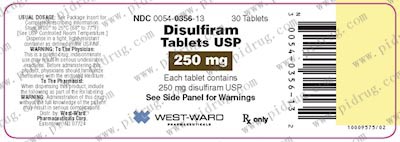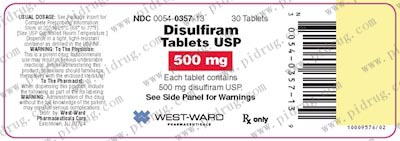药品详情:
【双硫仑disulfiram 简述】
本品为一种戒酒药物,服用该药后即使饮用少量的酒,身体也会产生严重不适,从而达到戒酒的目的。


【双硫仑disulfiram 适应症】
本品用于成年人酒精上瘾症。
【双硫仑disulfiram 规格】
本品为片剂,每片含有效成份250mg/500mg,每瓶30片装。
【双硫仑disulfiram 服用方法】
每天500mg。
【双硫仑disulfiram 注意事项】
许多抗菌药具有与双硫仑相似的作用,用药后若饮酒,会发生面部潮红、眼结膜充血、视觉模糊、头颈部血管剧烈搏动或搏动性头痛、头晕,恶心、呕吐、出汗、口干、胸痛、心肌梗塞、急性心衰、呼吸困难、急性肝损伤,惊厥及死亡等,查体时可有血压下降、心率加速(可达120次/min)及心电图正常或部分改变(如ST—T改变)。其严重程度与用药剂量和饮酒量成正比关系,老年人、儿童、心脑血管病及对乙醇敏感者更为严重,这种反应一般在用药与饮酒后15-30分钟或静脉输入含乙醇的注射剂时发生。
【双硫仑disulfiram 不良反应】
会发生面部潮红、眼结膜充血、视觉模糊、头颈部血管剧烈搏动或搏动性头痛、头晕,恶心、呕吐、出汗、口干、胸痛、心肌梗塞、急性心衰、呼吸困难、急性肝损伤,惊厥及死亡。
Disulfiram
Disulfiram (sold under the trade names Antabuse and Antabus) is a drug used to support the treatment of chronic alcoholism by producing an acute sensitivity to ethanol (drinking alcohol). Disulfiram works by inhibiting the enzyme acetaldehyde dehydrogenase, which means that many of the effects of a hangover are felt immediately after alcohol is consumed. "Disulfiram plus alcohol, even small amounts, produce flushing, throbbing in head and neck, throbbing headache, respiratory difficulty, nausea, copious vomiting, sweating, thirst, chest pain, palpitation, dyspnea, hyperventilation, tachycardia, hypotension, syncope, marked uneasiness, weakness, vertigo, blurred vision, and confusion. In severe reactions there may be respiratory depression, cardiovascular collapse, arrhythmias, myocardial infarction, acute congestive heart failure, unconsciousness, convulsions, and death."[1]
In the body, alcohol is converted to acetaldehyde, which is then broken down by acetaldehyde dehydrogenase. If the dehydrogenase enzyme is inhibited, acetaldehyde builds up and causes unpleasant effects. Disulfiram should be used in conjunction with counseling and support.
Disulfiram has been studied as a possible treatment for cancer[2] and latent HIV infection.[3]
Uses
Disulfiram is used as a second line treatment,behind acamprosate and naltrexone, for alcohol dependence.[4]
Under normal metabolism, alcohol is broken down in the liver by the enzymealcohol dehydrogenase to acetaldehyde, which is then converted by the enzyme acetaldehyde dehydrogenase to a harmless acetic acid derivative (acetyl coenzyme A). Disulfiram blocks this reaction at the intermediate stage by blocking acetaldehyde dehydrogenase. After alcohol intake under the influence of disulfiram, the concentration of acetaldehyde in the blood may be five to 10 times higher than that found during metabolism of the same amount of alcohol alone. As acetaldehyde is one of the major causes of the symptoms of a "hangover," this produces immediate and severe negative reaction to alcohol intake. About 5 to 10 minutes after alcohol intake, the patient may experience the effects of a severe hangover for a period of 30 minutes up to several hours. Symptoms include flushing of the skin, accelerated heart rate, shortness of breath, nausea, vomiting, throbbing headache, visual disturbance, mental confusion, postural syncope, and circulatory collapse.
Disulfiram should not be taken if alcohol has been consumed in the last 12 hours.[5] There is no tolerance to disulfiram: the longer it is taken, the stronger its effects.[1] As disulfiram is absorbed slowly through the digestive tract and eliminated slowly by the body, the effects may last for up to two weeks after the initial intake; consequently, medical ethics dictate that patients must be fully informed about the disulfiram-alcohol reaction.[6]
Disulfiram does not reduce alcohol cravings, so a major problem associated with this drug is extremely poor compliance. Methods to improve compliance include subdermal implants, which release the drug continuously over a period of up to 12 weeks, and supervised administration practices, for example, having the drug regularly administered by one's spouse.[medical citation needed]
Although disulfiram remained the most common pharmaceutical treatment of alcohol abuse till the end of the 20th century, today it is often replaced or accompanied with newer drugs, primarily the combination of naltrexone and acamprosate, which directly attempt to address physiological processes in the brain associated with alcohol abuse.
Side effects in abence of alcohol
The most common side effects in the absence of alcohol are headache, and a metallic or garlic taste in the mouth, though more severe side effects may occur.[7]Tryptophol, a chemical compound that induces sleep in humans, is formed in the liver after disulfiram treatment.[8] Less common side effects include decrease in libido, liver problems, skin rash, and nerve inflammation.[9] Liver toxicity is an uncommon but potentially serious side effect, and risk groups e.g. those with already impaired liver function should be monitored closely. That said, the rate of disulfiram-induced hepatitis are estimated to be in between 1 per 25,000 to 1 in 30,000,[10] and rarely the primary cause for treatment cessation.
Cases of disulfiram neurotoxicity have also occurred, causing extrapyramidal and other symptoms.[11] Disulfiram (Antabuse) can produce neuropathy in daily doses of less than the usually recommended 500 mg. Nerve biopsies showed axonal degeneration and the neuropathy is difficult to distinguish from that associated with ethanol abuse. Disulfiram neuropathy occurs after a variable latent period (mean 5 to 6 months) and progresses steadily. Slow improvement may occur when the drug's use is stopped; often there is complete recovery eventually.[12]
Disulfiram disrupts metabolism of several other compounds, including paracetamol (acetaminophen),[13] theophylline[14] and caffeine.[15] However, in most cases, this disruption is mild and presents itself as a 20–40% increase in the half-life of the compound at typical dosages of disulfiram.
注:药品如有新包装,以新包装为准。以上资讯来源于网络或由高等医药院校的学生志愿者翻译(如有错漏,请帮忙指正),仅供医护人员内部讨论,不作任何用药依据,具体用药指引,请咨询主治医师。
如您发现本网站有文字编辑或内容错误,请点击此处发送(需要安装有foxmail或outlook支持),
或发邮件至:info@pidrug.com,香港济民药业感谢您的到访!
欢迎您添加香港济民药业微信,或在公众号内留言。




